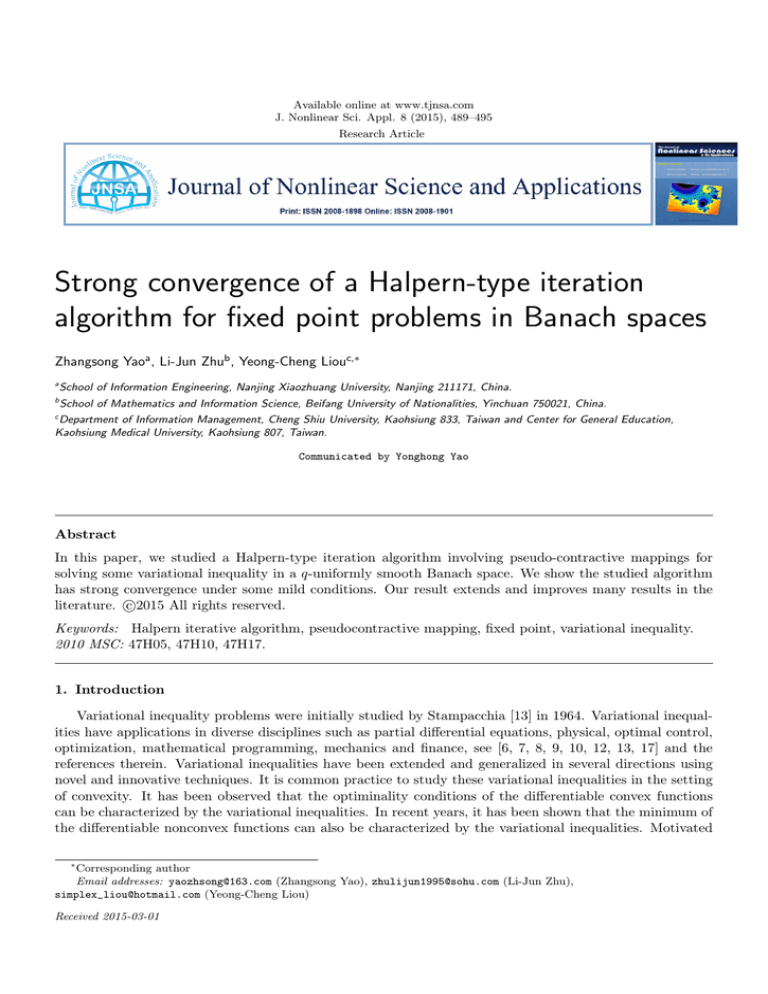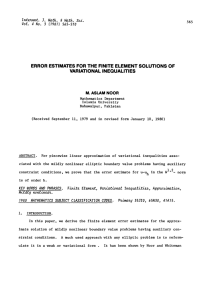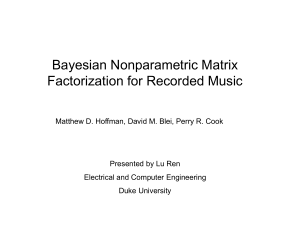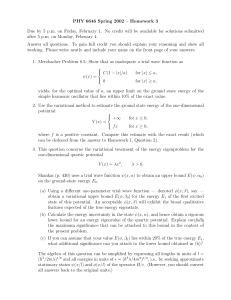
Available online at www.tjnsa.com
J. Nonlinear Sci. Appl. 8 (2015), 489–495
Research Article
Strong convergence of a Halpern-type iteration
algorithm for fixed point problems in Banach spaces
Zhangsong Yaoa , Li-Jun Zhub , Yeong-Cheng Liouc,∗
a
School of Information Engineering, Nanjing Xiaozhuang University, Nanjing 211171, China.
b
School of Mathematics and Information Science, Beifang University of Nationalities, Yinchuan 750021, China.
c
Department of Information Management, Cheng Shiu University, Kaohsiung 833, Taiwan and Center for General Education,
Kaohsiung Medical University, Kaohsiung 807, Taiwan.
Communicated by Yonghong Yao
Abstract
In this paper, we studied a Halpern-type iteration algorithm involving pseudo-contractive mappings for
solving some variational inequality in a q-uniformly smooth Banach space. We show the studied algorithm
has strong convergence under some mild conditions. Our result extends and improves many results in the
c
literature. ⃝2015
All rights reserved.
Keywords: Halpern iterative algorithm, pseudocontractive mapping, fixed point, variational inequality.
2010 MSC: 47H05, 47H10, 47H17.
1. Introduction
Variational inequality problems were initially studied by Stampacchia [13] in 1964. Variational inequalities have applications in diverse disciplines such as partial differential equations, physical, optimal control,
optimization, mathematical programming, mechanics and finance, see [6, 7, 8, 9, 10, 12, 13, 17] and the
references therein. Variational inequalities have been extended and generalized in several directions using
novel and innovative techniques. It is common practice to study these variational inequalities in the setting
of convexity. It has been observed that the optiminality conditions of the differentiable convex functions
can be characterized by the variational inequalities. In recent years, it has been shown that the minimum of
the differentiable nonconvex functions can also be characterized by the variational inequalities. Motivated
∗
Corresponding author
Email addresses: yaozhsong@163.com (Zhangsong Yao), zhulijun1995@sohu.com (Li-Jun Zhu),
simplex_liou@hotmail.com (Yeong-Cheng Liou)
Received 2015-03-01
Z. Yao, L. J. Zhu, Y. C. Liou, J. Nonlinear Sci. Appl. 8 (2015), 489–495
490
and inspired by these developments, Noor [8] has introduced a new type of variational inequality involving
two nonlinear operators, which is called the general variational inequality. It is worth mentioning that this
general variational inequality is remarkable different from the so-called general variational inequality which
was introduced by Noor [6] in 1988. Noor [8] proved that the general variational inequalities are equivalent
to nonlinear projection equations and the Wiener-Hopf equations by using the projection technique. Using
this equivalent formulation, Noor [8] suggested and analyzed some iterative algorithms for solving the special
general variational inequalities and further proved these algorithms have strong convergence. Related to
the variational inequalities, we have the problem of finding the fixed points of the nonexpansive mappings,
which is the subject of current interest in functional analysis. It is our purpose in this paper, we studied
a Halpern-type iteration algorithm involving pseudo-contractive mappings for solving some variational inequality in a q-uniformly smooth Banach space. We show the studied algorithm has strong convergence
under some mild conditions. Our result extends and improves many results in the literature.
To be more precise, let C be a nonempty closed convex subset of a real Banach space E. Let A : C → E
be a nonlinear operator. The variational inequality problem is formulated as finding a point x∗ ∈ C such
that, for some j(x − x∗ ) ∈ J(x − y),
⟨Ax∗ , j(x − x∗ )⟩ ≥ 0,
for all x ∈ C.
Recall that a mapping T : C → C is said to be strictly pseudo-contractive (in the terminology of BrowderPetryshyn) if there exists a constant λ > 0 such that, for all x, y ∈ C, there exists jq (x − y) ∈ Jq (x − y) such
that
⟨(I − T )x − (I − T )y, jq (x − y)⟩ ≥ λ∥(I − T )x − (I − T )y∥q ,
(1.1)
where I denotes the identity operator on C. We denote by F (T ) the set of fixed points of a mapping
T : C → C, that is F (T ) = {x ∈ C : T x = x}. This class of mappings was introduced actually in a Hilbert
space by Browder and Petryshyn [1].
Recall also that a mapping f : C → C is said to be contractive if there exists a constant ρ ∈ (0, 1) such
that
∥f (x) − f (y)∥ ≤ ρ∥x − y∥,
for all x, y ∈ C.
Numerous papers have been written on the approximation of fixed points of strictly pseudo-contractive
mappings (see [3, 4, 5, 11, 18, 19, 20, 21, 22] and the references contained therein). In particular, recently,
Chidume and Souza [2] introduced a Halpern-type iterative algorithm for a strictly pseudo-contractive
mapping and proved the following strong convergence theorem:
Theorem 1.1. Let E be a real reflexive Banach space with uniformly Gâteaux differentiable norm. Let C
be a nonempty bounded closed and convex subset of E. Let T : C → C be a strictly pseudo-contractive
mapping. Assume F (T ) ̸= ∅ and let z ∈ F (T ). Fix δ ∈ (0, 1) and let δ ∗ be such that δ ∗ := δL ∈ (0, 1).
Define Sn x := (1 − δn )x + δn T x for all x ∈ C, where δn ∈ (0, 1) and lim δn = 0. Let {αn } be a real sequence
in (0, 1) which satisfies the following conditions:
(C1) lim
∑ αn = 0;
(C2) ∞
n=1 αn = ∞.
For arbitrary x0 , u ∈ C, define a sequence {xn } in K by
xn+1 = αn u + (1 − αn )Sn xn ,
∀n ≥ 1.
Then {xn } converges strongly to a fixed point of T .
In the proof lines of Theorem 1.1, we point out some problems as follows:
Z. Yao, L. J. Zhu, Y. C. Liou, J. Nonlinear Sci. Appl. 8 (2015), 489–495
491
Remark 1.2. First, we note that there exists a big gap in the proof of Theorem 1.1. In Theorem 1.1, they
asserted that the sequence {ztn } generated by ztn = tn u + (1 − tn )Sn ztn converges to a fixed point of T .
Unfortunately, this conclusion is false. Indeed, noting that
ztn = tn u + (1 − tn )(1 − δn )ztn + (1 − tn )δn T ztn ,
it follows that
tn
(1 − tn )δn
u+
T ztn
δn + tn − tn δn
δ n + tn − tn δ n
1
(1 − tn )δn
= δn
T ztn .
u+
δ n + tn − tn δ n
t + 1 − δn
ztn =
n
Thus, from the conditions δn → 0 and δn = o(tn ), we have
1
δn
+1−δn
tn
→ 1 and so the application of Lemma
MJ fails. This indicates that {ztn } does not converge to a fixed point of T . Therefore, Theorem 1.1 is
dubious.
In this paper, we studied a Halpern-type viscosity iteration algorithm involving pseudo-contractive mapping T in a q-uniformly smooth Banach space. for solving some variational inequality We show the studied
algorithm strongly converges to a fixed point of T which solves some variational inequality in Banach spaces
under some mild conditions. Our result modifies the main result in Chidume and Souza [2] and extends and
improves many other results in the literature.
2. Preliminaries
Let E be a real Banach space. The modulus of smoothness of E is defined as the function ρE : [0, ∞) →
[0, ∞):
1
ρE (τ ) = sup{ (∥x + y∥ + ∥x − y∥) − 1 : ∥x∥ ≤ 1, ∥y∥ ≤ τ }.
2
E is said to be uniformly smooth if and only if limτ →0+ (ρE (τ )/τ ) = 0. Let q > 1. The space E is said to
be q-uniformly smooth (or to have a modulus of smoothness of power type q > 1), if there exists a constant
cq > 0 such that ρE (τ ) ≤ cq τ q . It is well known that Hilbert spaces, Lp and lp spaces, 1 < p < ∞, as well
p
as the Sobolev spaces, Wm
, 1 < p < ∞, are q-uniformly smooth.
Now, we give some lemmas which will be used in the proof of the main result in the next section.
Lemma 2.1. ([15]) Let q > 1 and E be a real smooth Banach space. Then the following are equivalent:
(1) E is q-uniformly smooth;
(2) There exists a constant cq > 0 such that, for all x, y ∈ E,
∥x + y∥q ≤ ∥x∥q + q⟨y, jq (x)⟩ + cq ∥y∥q .
Lemma 2.2. ([16]) Let C be a nonempty closed convex subset of a uniformly smooth Banach space E. Let
f : C → C be a ρ-contraction. Let T : C → C be a nonexpansive mapping such that F (T ) ̸= ∅. For
t ∈ (0, 1), defined a net {xt } in C by xt = tf (xt ) + (1 − t)T xt . Then as t → 0, the net {xt } converges
strongly to p ∈ F ()T which solves the following variational inequality
⟨(I − f )p, j(x − p)⟩ ≥ 0, for all
x ∈ F (T ).
Lemma 2.3. ([14]) Let {xn } and {yn } be bounded sequences in a Banach space E such that
xn+1 = σn xn + (1 − σn )yn
where {σn } is a sequence in [0, 1] such that
0 < lim inf αn ≤ lim sup αn < 1.
n→∞
n→∞
Z. Yao, L. J. Zhu, Y. C. Liou, J. Nonlinear Sci. Appl. 8 (2015), 489–495
492
Assume
lim sup(∥yn+1 − yn ∥ − ∥xn+1 − xn ∥) ≤ 0.
n→∞
Then limn→∞ ∥yn − xn ∥ = 0.
Lemma 2.4. ([16]) Assume {an } is a sequence of nonnegative real numbers such that an+1 ≤ (1−γn )an +δn
where {γ
∑n } is a sequence in (0, 1) and {δn } is a sequence such that
(1) ∞
n=1 γn = ∞;
∑
(2) lim supn→∞ γδnn ≤ 0 or ∞
n=1 |δn | < ∞.
Then limn→∞ an = 0.
3. Main Results
Now, we give the main results in this paper.
Theorem 3.1. Let C be a nonempty closed convex subset of a q-uniformly smooth Banach space E. Let
f : C → C be a ρ-contraction. Let T : C → C be a strictly pseudo-contractive mapping such that F (T ) ̸= ∅.
For t ∈ (0, 1), defined a net {xt } by xt = tf (xt ) + (1 − t)T xt . Then, as t → 0, the net {xt } converges strongly
to p ∈ F (T ) which solves the following variational inequality
⟨(I − f )p, j(x − p)⟩ ≥ 0, for all
x ∈ F (T ).
1
q−1 }). Indeed,
Proof. First, we note that (1 − δ)I + δT is nonexpansive mapping for all δ ∈ (0, min{1, ( qλ
cq )
from (1.1) and Lemma 2.1, we have
∥(1 − δ)(x − y) + δ(T x − T y)∥q
= ∥(x − y) − δ[x − T x − (y − T y)]∥q
≤ ∥x − y∥q − qδ⟨x − T x − (y − T y), jq (x − y)⟩
+ cq δ q ∥x − T x − (y − T y)∥q
≤ ∥x − y∥q − qδλ∥x − T x − (y − T y)∥q
+ cq η q ∥x − T x − (y − T y)∥q
= ∥x − y∥q + (cq δ q − qδλ)∥x − T x − (y − T y)∥q
≤ ∥x − y∥q
and so
∥(1 − δ)(x − y) + δ(T x − T y)∥ ≤ ∥x − y∥.
Hence (1 − δ)I + δT is nonexpansive.
For s ∈ (0, 1), we consider the mapping S : C → C defined by
Sx = sf (x) + (1 − s)[(1 − δ)x + δT x],
∀x ∈ C.
It is clear that S is a contraction on C. Therefore, there exists a unique fixed point xs of S in C. That is,
xs solves the equation
xs = sf (xs ) + (1 − s)[(1 − δ)xs + δT xs ], x ∈ C.
It follows that
sf (xs )
δ(1 − s)
xs =
+
T xs .
δ + (1 − δ)s δ + (1 − δ)s
Taking s =
δt
1−(1−δ)t
in (3.1), we have
xt = tf (xt ) + (1 − t)T xt .
(3.1)
Z. Yao, L. J. Zhu, Y. C. Liou, J. Nonlinear Sci. Appl. 8 (2015), 489–495
493
Therefore, from Lemma 2.2, we know that, as s → 0, {xs } converges strongly to p ∈ F ()T which solves the
variational inequality
⟨(I − f )p, j(x − p)⟩ ≥ 0, for all x ∈ F (T ).
This completes the proof.
Theorem 3.2. Let C be a nonempty closed convex subset of a q-uniformly smooth Banach space E. Let
f : C → C be a ρ-contraction. Let T : C → C be a strictly pseudo-contractive mapping such that F (T ) ̸= ∅.
Define a mapping S : C → C by Sx = (1 − δ)x + δT x for all x ∈ C, where δ = (1 − σ)η for any σ ∈ (0, 1)
1
q−1 }). Let {α } be a real sequence in (0, 1) which satisfies the following conditions:
and η ∈ (0, min{1, ( qλ
n
cq )
(C1) lim
∑ n→∞ αn = 0;
(C2)
αn = ∞.
For arbitrary x0 ∈ C, define a sequence {xn } in C by
xn+1 = αn f (xn ) + (1 − αn )Sxn ,
∀n ≥ 0.
(3.2)
Then {xn } converges strongly to p ∈ F (T ) which solves the variational inequality
⟨(I − f )p, j(x − p)⟩ ≥ 0, for all
x ∈ F (T ).
Proof. We first show that the sequence {xn } is bounded.
1
q−1 }). Hence, S is a nonexpansive mapping. At the same time, it
We note that δ < η ∈ (0, min{1, ( qλ
cq )
is clear that F (T ) = F (S).
Take x∗ ∈ F (T ). From (3.2), we have
∥xn+1 − x∗ ∥ = ∥αn (f (xn ) − x∗ ) + (1 − αn )(Sxn − x∗)∥
≤ αn ∥f (xn ) − f (x∗ )∥ + αn ∥f (x∗ ) − x∗ ∥ + (1 − αn )∥Sxn − x∗ ∥
≤ [1 − (1 − ρ)αn ]∥xn − x∗ ∥ + αn ∥f (x∗ ) − x∗ ∥
∥f (x∗ ) − x∗ ∥
, ∥xn − x∗ ∥}.
≤ max{
1−ρ
By induction, we obtain, for all n ≥ 0,
∥xn − x∗ ∥ ≤ max{
∥f (x∗ ) − x∗ ∥
, ∥x0 − x∗ ∥}.
1−ρ
Hence {xn } is bounded and so is {Sxn }. From (3.2), we observe that
Sxn − σxn = [(1 − η + ση)xn + (η − ση)T xn ] − σxn
= (1 − σ)[(1 − η)xn + ηT xn ].
Define a sequence {xn } in C by xn+1 = σxn + (1 − σ)yn for all n ≥ 0. Then we obtain
αn f (xn ) + (1 − αn )Sxn − σxn
1−σ
αn (f (xn ) − Sxn ) Sxn − σxn
=
+
1−σ
1−σ
αn (f (xn ) − Sxn )
=
+ (1 − η)xn + ηT xn
1−σ
yn =
and so
∥yn+1 − yn ∥
αn+1 (∥f (xn )∥ + ∥Sxn+1 ∥) + αn (∥f (xn )∥ + ∥Sxn ∥)
≤
1−σ
+ ∥(1 − η)(xn+1 − xn ) + η(T xn+1 − T xn )∥
αn+1 (∥f (xn )∥ + ∥Sxn+1 ∥) + αn (∥f (xn )∥ + ∥Sxn ∥)
≤
+ ∥xn+1 − xn ∥,
1−σ
Z. Yao, L. J. Zhu, Y. C. Liou, J. Nonlinear Sci. Appl. 8 (2015), 489–495
494
which implies that
lim sup(∥yn+1 − yn ∥ − ∥xn+1 − xn ∥) ≤ 0.
n→∞
Hence, by Lemma 2.3, ∥yn − xn ∥ → 0 and so limn→∞ ∥xn+1 − xn ∥ = 0, which implies that limn→∞ ∥xn −
Sxn ∥ = limn→∞ ∥xn − T xn ∥ = 0.
Next, we show that
lim sup⟨f (p) − p, j(xn − p)⟩ ≤ 0,
n→∞
where p = limt→0 xt and xt = tf (xt ) + (1 − t)T xt .
We note that xt − xn = t(f (xt ) − xn ) + (1 − t)(T xt − xn ). It follows that
∥xt − xn ∥2 = t⟨f (xt ) − xn , j(xt − xn )⟩ + (1 − t)⟨T xt − xn , j(xt − xn )⟩
= t⟨f (xt ) − xt , j(xt − xn )⟩ + t⟨xt − xn , j(xt − xn )⟩
+ (1 − t)⟨T xt − T xn , j(xt − xn )⟩ + (1 − t)⟨T xn − xn , j(xt − xn )⟩
≤ ∥xt − xn ∥2 + ∥T xn − xn ∥∥xt − xn ∥ + t⟨f (xt ) − xt , j(xt − xn )⟩.
It follows that
⟨f (xt ) − xt , j(xn − xt )⟩ ≤
∥T xn − xn ∥∥xt − xn ∥
,
t
which implies that
lim sup⟨f (xt ) − xt , j(xn − xt )⟩ ≤ 0.
n→∞
It follows that
lim sup⟨f (p) − p, j(xn − p)⟩ ≤ 0.
(3.3)
n→∞
Finally, we prove that xn → p. From (3.2), we have
∥xn+1 − p∥2 = ∥αn (f (xn ) − p) + (1 − αn )(Sxn − p)∥2
≤ (1 − αn )2 ∥Sxn − p∥2 + 2αn ⟨f (xn ) − f (p), j(xn+1 − p)⟩
+ 2αn ⟨f (p) − p, j(xn+1 − p)⟩
≤ (1 − αn )2 ∥xn − p∥2 + 2αn ρ∥xn − p∥∥xn+1 − p∥
+ 2αn ⟨f (p) − p, j(xn+1 − p)⟩
≤ (1 − αn )2 ∥xn − p∥2 + αn ρ(∥xn − p∥2 + ∥xn+1 − p∥2 )
+ 2αn ⟨f (p) − p, j(xn+1 − p)⟩,
that is,
1 − (2 − ρ)αn + αn2
∥xn − p∥2
1 − ραn
2 − αn
+
⟨f (p) − p, j(xn+1 − p)⟩
1 − ραn
2(1 − ρ)αn
αn2
= [1 −
]∥xn − p∥2 +
∥xn − p∥2
1 − ραn
1 − ραn
2αn
+
⟨f (p) − p, j(xn+1 − p)⟩.
1 − ραn
∥xn+1 − p∥2 ≤
(3.4)
From (3.3), (3.4) and Lemma 2.4, we deduce immediately the desired result. This completes the proof.
Remark 3.3. We correct the gap in the proof of Theorem 1.1 and, at the same time, we drop the boundedness
assumption on C.
Z. Yao, L. J. Zhu, Y. C. Liou, J. Nonlinear Sci. Appl. 8 (2015), 489–495
495
Remark 3.4. It is worth of mentioning that our proof is very simpler than that of Theorem 1.1.
Remark 3.5. We would like to point out that we prove a strong convergence result on pseudocontractive
mappings which solves some variational inequality under conditions (C1) and (C2) on algorithm parameters
{αn }.
Acknowledgment
Li-Jun Zhu was supported in part by NNSF of China (61362033). Yeong-Cheng Liou was supported
in part by NSC 101-2628-E-230-001-MY3 and NSC 103-2923-E-037-001-MY3. This research is supported
partially by Kaohsiung Medical University Aim for the Top Universities Grant, grant No. KMU-TP103F00.
References
[1] F. E. Browder, W. V. Petryshyn, Construction of fixed points of nonlinear mappings in Hilbert spaces, J. Math.
Anal. Appl., 20 (1967), 197–228. 1
[2] C. O. Chidume, G. De Souza, Convergence of a Halpern-type iteration algorithm for a class of pseudocontractive
mappings, Nonliear Anal., 69 (2008), 2286–2292. 1, 1
[3] P. Li, S. M. Kang, L. Zhu, Visco-resolvent algorithms for monotone operators and nonexpansive mappings, J.
Nonlinear Sci. Appl., 7 (2014), 325–344. 1
[4] G. Marino, H. K. Xu, Weak and strong convergence theorems for strictly pseudocontractions in Hilbert spaces, J.
Math. Anal. Appl., 329 (2007), 336–346. 1
[5] C. H. Morales, J. S. Jung, Convergence of paths for pseudocontractive mappings in Banach spaces, Proc. Amer.
Math. Soc., 128 (2000), 3411–3419. 1
[6] M. A. Noor, General variational inequalities, Appl. Math. Lett., 1 (1988), 119–121. 1
[7] M. A. Noor, Some developments in general variational inequalities, Appl. Math. Comput., 152 (2004), 199–277.
1
[8] M. A. Noor, Differentiable nonconvex functions and general variational inequalities, Appl. Math. Comput., 199
(2008), 623–630. 1
[9] M. A. Noor, K. I. Noor, Self-adaptive projection algorithms for general variational inequalities, Appl. Math.
Comput., 151 (2004), 659–670. 1
[10] M. A. Noor, K. I. Noor, Th. M. Rassias, Some aspects of variational inequalities, J. Comput. Appl. Math., 47
(1993), 285–312. 1
[11] M. O. Osilike, A. Udomene, Demiclosedness principle and convergence theorems for strictly pseudocontractive
mappings of Browder-Petryshyn Type, J. Math. Anal. Appl., 256 (2001), 431–445. 1
[12] P. Shi, Equivalence of variational inequalities with Wiener-Hopf equations, Proc. Amer. Math. Soc., 111 (1991),
339–346. 1
[13] G. Stampacchia, Formes bilineaires coercitives sur les ensembles convexes, C.R. Acad. Sci. Paris, 258 (1964),
4413–4416. 1
[14] T. Suzuki, Strong convergence theorems for infinite families of nonexpansive mappings in general Banach spaces,
Fixed Point Theory Appl., 2005 (2005), 103–123. 2.3
[15] H. K. Xu, Inequalities in Banach spaces with applications, Nonlinear Anal., 16 (1991), 1127–1138. 2.1
[16] H. K. Xu, Viscosity approximation methods for non-expansive mappings, J. Math. Anal. Appl., 298 (2004),
279–291. 2.2, 2.4
[17] J. C. Yao, Variational inequalities with generalized monotone operators, Math. Operations Research, 19 (1994),
691–705. 1
[18] Y. Yao, Y. J. Cho, Y. C. Liou, R. P. Agarwal, Constructed nets with perturbations for equilibrium and fixed point
problems, J. Inequal. Appl., 2014 (2014), 14 pages. 1
[19] Y. Yao, Y. C. Liou, C. C. Chyu, Fixed points of pseudocontractive mappings by a projection method in Hilbert
spaces, J. Nonlinear Convex Anal., 14 (2013), 785–794. 1
[20] Y. Yao, Y. C. Liou, S. M. Kang, Coupling extragradient methods with CQ mathods for equilibrium points, pseudomontone variational inequalities and fixed points, Fixed Point Theory, 15 (2014), 311–324. 1
[21] Y. Yao, M. Postolache, S. M. Kang, Strong convergence of approximated iterations for asymptotically pseudocontractive mappings, Fixed Point Theory Appl., 2014 (2014) 13 pages. 1
[22] H. Y. Zhou, Convergence theorems of fixed points for k-strict pseudocontractions in Hilbert spaces, Nonlinear
Anal., 69 (2008), 456–462. 1






